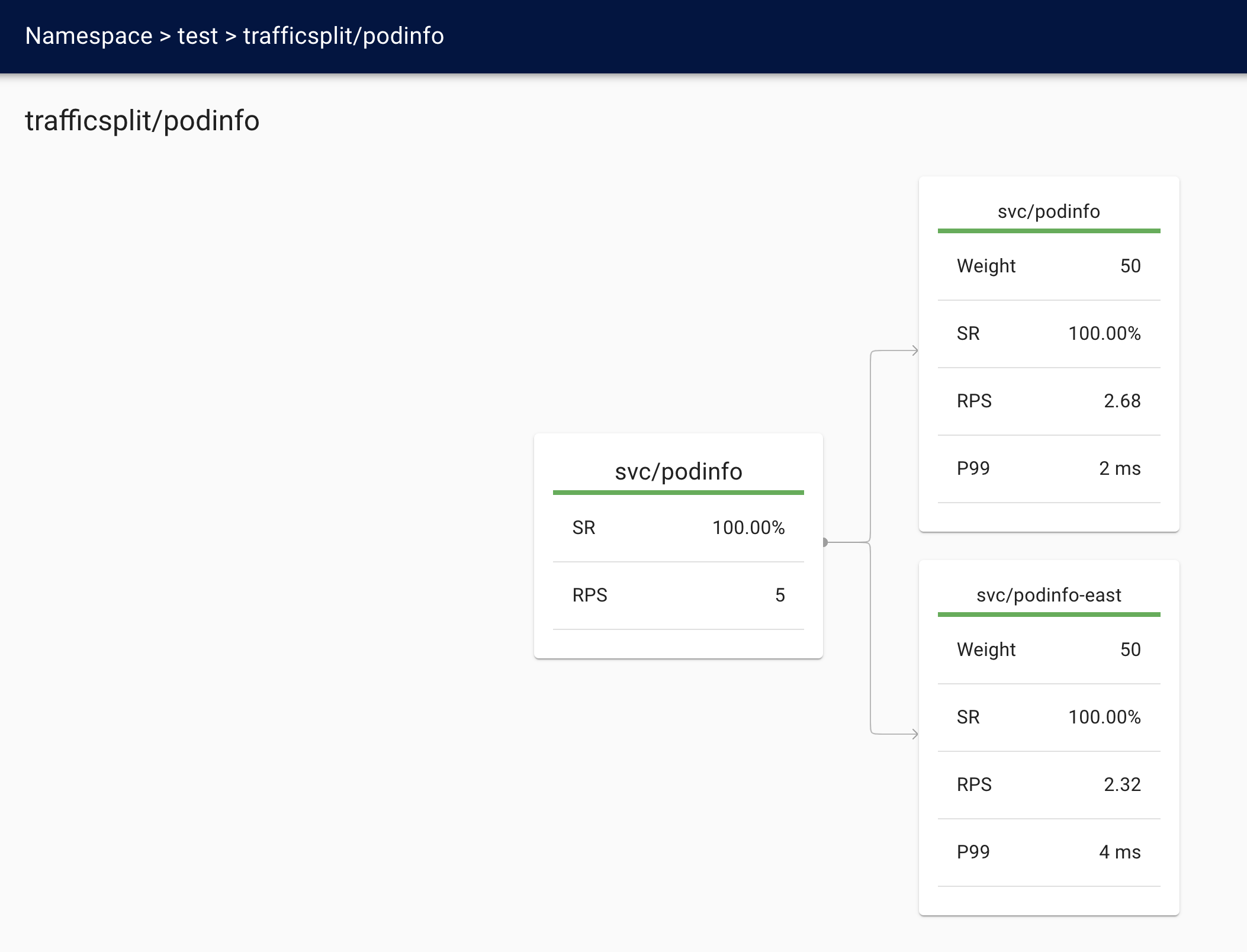Multi-cluster communication
This guide will walk you through installing and configuring Linkerd so that two clusters can talk to services hosted on both. There are a lot of moving parts and concepts here, so it is valuable to read through our introduction that explains how this works beneath the hood. By the end of this guide, you will understand how to split traffic between services that live on different clusters.
At a high level, you will:
- Install Linkerd and Linkerd Viz on two clusters with a shared trust anchor.
- Prepare the clusters.
- Link the clusters.
- Install the demo.
- Export the demo services, to control visibility.
- Gain visibility in your linked clusters.
- Verify the security of your clusters.
- Split traffic from pods on the source cluster (
west) to the target cluster (east)
Prerequisites
- Two clusters. We will refer to them as
eastandwestin this guide. Follow along with the blog post as you walk through this guide! The easiest way to do this for development is running a kind or k3d cluster locally on your laptop and one remotely on a cloud provider, such as AKS. - Each of these clusters should be configured as
kubectlcontexts. We’d recommend you use the nameseastandwestso that you can follow along with this guide. It is easy to rename contexts withkubectl, so don’t feel like you need to keep it all named this way forever. - Elevated privileges on both clusters. We’ll be creating service accounts and granting extended privileges, so you’ll need to be able to do that on your test clusters.
- Support for services of type
LoadBalancerin theeastcluster. Check out the documentation for your cluster provider or take a look at inlets. This is what thewestcluster will use to communicate witheastvia the gateway.
Install Linkerd and Linkerd Viz

Linkerd requires a shared
trust anchor
to exist between the installations in all clusters that communicate with each
other. This is used to encrypt the traffic between clusters and authorize
requests that reach the gateway so that your cluster is not open to the public
internet. Instead of letting linkerd generate everything, we’ll need to
generate the credentials and use them as configuration for the install
command.
We like to use the step CLI to generate these
certificates. If you prefer openssl instead, feel free to use that! To
generate the trust anchor with step, you can run:
step certificate create root.linkerd.cluster.local root.crt root.key \
--profile root-ca --no-password --insecure
This certificate will form the common base of trust between all your clusters. Each proxy will get a copy of this certificate and use it to validate the certificates that it receives from peers as part of the mTLS handshake. With a common base of trust, we now need to generate a certificate that can be used in each cluster to issue certificates to the proxies. If you’d like to get a deeper picture into how this all works, check out the deep dive.
The trust anchor that we’ve generated is a self-signed certificate which can be used to create new certificates (a certificate authority). To generate the issuer credentials using the trust anchor, run:
step certificate create identity.linkerd.cluster.local issuer.crt issuer.key \
--profile intermediate-ca --not-after 8760h --no-password --insecure \
--ca root.crt --ca-key root.key
An identity service in your cluster will use the certificate and key that you
generated here to generate the certificates that each individual proxy uses.
While we will be using the same issuer credentials on each cluster for this
guide, it is a good idea to have separate ones for each cluster. Read through
the certificate documentation for more
details.
With a valid trust anchor and issuer credentials, we can install Linkerd on your
west and east clusters now.
# first, install the Linkerd CRDs in both clusters
linkerd install --crds \
| tee \
>(kubectl --context=west apply -f -) \
>(kubectl --context=east apply -f -)
# then install the Linkerd control plane in both clusters
linkerd install \
--identity-trust-anchors-file root.crt \
--identity-issuer-certificate-file issuer.crt \
--identity-issuer-key-file issuer.key \
| tee \
>(kubectl --context=west apply -f -) \
>(kubectl --context=east apply -f -)
And then Linkerd Viz:
for ctx in west east; do
linkerd --context=${ctx} viz install | \
kubectl --context=${ctx} apply -f - || break
done
The output from install will get applied to each cluster and come up! You can
verify that everything has come up successfully with check.
for ctx in west east; do
echo "Checking cluster: ${ctx} ........."
linkerd --context=${ctx} check || break
echo "-------------"
done
Preparing your cluster

In order to route traffic between clusters, Linkerd leverages Kubernetes
services so that your application code does not need to change and there is
nothing new to learn. This requires a gateway component that routes incoming
requests to the correct internal service. The gateway will be exposed to the
public internet via a Service of type LoadBalancer. Only requests verified
through Linkerd’s mTLS (with a shared trust anchor) will be allowed through this
gateway. If you’re interested, we go into more detail as to why this is
important in architecting for multicluster Kubernetes.
To install the multicluster components on both west and east, you can run:
for ctx in west east; do
echo "Installing on cluster: ${ctx} ........."
linkerd --context=${ctx} multicluster install | \
kubectl --context=${ctx} apply -f - || break
echo "-------------"
done

Installed into the linkerd-multicluster namespace, the gateway is a simple
pause container
which has been injected with the Linkerd proxy. On the inbound side, Linkerd
takes care of validating that the connection uses a TLS certificate that is part
of the trust anchor, then handles the outbound connection. At this point, the
Linkerd proxy is operating like any other in the data plane and forwards the
requests to the correct service. Make sure the gateway comes up successfully by
running:
for ctx in west east; do
echo "Checking gateway on cluster: ${ctx} ........."
kubectl --context=${ctx} -n linkerd-multicluster \
rollout status deploy/linkerd-gateway || break
echo "-------------"
done
Double check that the load balancer was able to allocate a public IP address by running:
for ctx in west east; do
printf "Checking cluster: ${ctx} ........."
while [ "$(kubectl --context=${ctx} -n linkerd-multicluster get service -o 'custom-columns=:.status.loadBalancer.ingress[0].ip' --no-headers)" = "<none>" ]; do
printf '.'
sleep 1
done
printf "\n"
done
Every cluster is now running the multicluster control plane and ready to start mirroring services. We’ll want to link the clusters together now!
Linking the clusters

For west to mirror services from east, the west cluster needs to have
credentials so that it can watch for services in east to be exported. You’d
not want anyone to be able to introspect what’s running on your cluster after
all! The credentials consist of a service account to authenticate the service
mirror as well as a ClusterRole and ClusterRoleBinding to allow watching
services. In total, the service mirror component uses these credentials to watch
services on east or the target cluster and add/remove them from itself
(west). There is a default set added as part of
linkerd multicluster install, but if you would like to have separate
credentials for every cluster you can run linkerd multicluster allow.
The next step is to link west to east. This will create a credentials
secret, a Link resource, and a service-mirror controller. The credentials secret
contains a kubeconfig which can be used to access the target (east) cluster’s
Kubernetes API. The Link resource is custom resource that configures service
mirroring and contains things such as the gateway address, gateway identity,
and the label selector to use when determining which services to mirror. The
service-mirror controller uses the Link and the secret to find services on
the target cluster that match the given label selector and copy them into
the source (local) cluster.
To link the west cluster to the east one, run:
linkerd --context=east multicluster link --cluster-name east |
kubectl --context=west apply -f -
Linkerd will look at your current east context, extract the cluster
configuration which contains the server location as well as the CA bundle. It
will then fetch the ServiceAccount token and merge these pieces of
configuration into a kubeconfig that is a secret.
Running check again will make sure that the service mirror has discovered this
secret and can reach east.
linkerd --context=west multicluster check
Additionally, the east gateway should now show up in the list:
linkerd --context=west multicluster gateways
Installing the test services

It is time to test this all out! The first step is to add some services that we can mirror. To add these to both clusters, you can run:
for ctx in west east; do
echo "Adding test services on cluster: ${ctx} ........."
kubectl --context=${ctx} apply \
-n test -k "github.com/linkerd/website/multicluster/${ctx}/"
kubectl --context=${ctx} -n test \
rollout status deploy/podinfo || break
echo "-------------"
done
You’ll now have a test namespace running two deployments in each cluster -
frontend and podinfo. podinfo has been configured slightly differently in each
cluster with a different name and color so that we can tell where requests are
going.
To see what it looks like from the west cluster right now, you can run:
kubectl --context=west -n test port-forward svc/frontend 8080

With the podinfo landing page available at
http://localhost:8080, you can see how it looks in the
west cluster right now. Alternatively, running curl http://localhost:8080
will return a JSON response that looks something like:
{
"hostname": "podinfo-5c8cf55777-zbfls",
"version": "4.0.2",
"revision": "b4138fdb4dce7b34b6fc46069f70bb295aa8963c",
"color": "#6c757d",
"logo": "https://raw.githubusercontent.com/stefanprodan/podinfo/gh-pages/cuddle_clap.gif",
"message": "greetings from west",
"goos": "linux",
"goarch": "amd64",
"runtime": "go1.14.3",
"num_goroutine": "8",
"num_cpu": "4"
}
Notice that the message references the west cluster name.
Exporting the services
To make sure sensitive services are not mirrored and cluster performance is
impacted by the creation or deletion of services, we require that services be
explicitly exported. For the purposes of this guide, we will be exporting the
podinfo service from the east cluster to the west cluster. To do this, we
must first export the podinfo service in the east cluster. You can do this
by adding the mirror.linkerd.io/exported label:
kubectl --context=east label svc -n test podinfo mirror.linkerd.io/exported=true
Check out the service that was just created by the service mirror controller!
kubectl --context=west -n test get svc podinfo-east
From the
architecture,
you’ll remember that the service mirror component is doing more than just moving
services over. It is also managing the endpoints on the mirrored service. To
verify that is setup correctly, you can check the endpoints in west and verify
that they match the gateway’s public IP address in east.
kubectl --context=west -n test get endpoints podinfo-east \
-o 'custom-columns=ENDPOINT_IP:.subsets[*].addresses[*].ip'
kubectl --context=east -n linkerd-multicluster get svc linkerd-gateway \
-o "custom-columns=GATEWAY_IP:.status.loadBalancer.ingress[*].ip"
At this point, we can hit the podinfo service in east from the west
cluster. This requires the client to be meshed, so let’s run curl from within
the frontend pod:
kubectl --context=west -n test exec -c nginx -it \
$(kubectl --context=west -n test get po -l app=frontend \
--no-headers -o custom-columns=:.metadata.name) \
-- /bin/sh -c "apk add curl && curl http://podinfo-east:9898"
You’ll see the greeting from east message! Requests from the frontend pod
running in west are being transparently forwarded to east. Assuming that
you’re still port forwarding from the previous step, you can also reach this
with curl http://localhost:8080/east. Make that call a couple times and
you’ll be able to get metrics from linkerd viz stat as well.
linkerd --context=west -n test viz stat --from deploy/frontend svc
We also provide a grafana dashboard to get a feel for what’s going on here (see
the grafana install instructions first to have a working grafana
provisioned with Linkerd dashboards). You can get to it by running linkerd --context=west viz dashboard and going to

Security
By default, requests will be going across the public internet. Linkerd extends its automatic mTLS across clusters to make sure that the communication going across the public internet is encrypted. If you’d like to have a deep dive on how to validate this, check out the docs. To quickly check, however, you can run:
linkerd --context=west -n test viz tap deploy/frontend | \
grep "$(kubectl --context=east -n linkerd-multicluster get svc linkerd-gateway \
-o "custom-columns=GATEWAY_IP:.status.loadBalancer.ingress[*].ip")"
tls=true tells you that the requests are being encrypted!
In addition to making sure all your requests are encrypted, it is important to block arbitrary requests coming into your cluster. We do this by validating that requests are coming from clients in the mesh. To do this validation, we rely on a shared trust anchor between clusters. To see what happens when a client is outside the mesh, you can run:
kubectl --context=west -n test run -it --rm --image=alpine:3 test -- \
/bin/sh -c "apk add curl && curl -vv http://podinfo-east:9898"
Traffic Splitting

It is pretty useful to have services automatically show up in clusters and be able to explicitly address them, however that only covers one use case for operating multiple clusters. Another scenario for multicluster is failover. In a failover scenario, you don’t have time to update the configuration. Instead, you need to be able to leave the application alone and just change the routing. If this sounds a lot like how we do canary deployments, you’d be correct!
TrafficSplit allows us to define weights between multiple services and split
traffic between them. In a failover scenario, you want to do this slowly as to
make sure you don’t overload the other cluster or trip any SLOs because of the
added latency. To get this all working with our scenario, let’s split between
the podinfo service in west and east. To configure this, you’ll run:
kubectl --context=west apply -f - <<EOF
apiVersion: split.smi-spec.io/v1alpha1
kind: TrafficSplit
metadata:
name: podinfo
namespace: test
spec:
service: podinfo
backends:
- service: podinfo
weight: 50
- service: podinfo-east
weight: 50
EOF
Any requests to podinfo will now be forwarded to the podinfo-east cluster
50% of the time and the local podinfo service the other 50%. Requests sent to
podinfo-east end up in the east cluster, so we’ve now effectively failed
over 50% of the traffic from west to east.
If you’re still running port-forward, you can send your browser to
http://localhost:8080. Refreshing the page should show
both clusters.Alternatively, for the command line approach,
curl localhost:8080 will give you a message that greets from west and
east.

You can also watch what’s happening with metrics. To see the source side of
things (west), you can run:
linkerd --context=west -n test viz stat trafficsplit
It is also possible to watch this from the target (east) side by running:
linkerd --context=east -n test viz stat \
--from deploy/linkerd-gateway \
--from-namespace linkerd-multicluster \
deploy/podinfo
There’s even a dashboard! Run linkerd viz dashboard and send your browser to
localhost:50750.

Cleanup
To cleanup the multicluster control plane, you can run:
linkerd --context=west multicluster unlink --cluster-name east | \
kubectl --context=west delete -f -
for ctx in west east; do \
kubectl --context=${ctx} delete ns test; \
linkerd --context=${ctx} multicluster uninstall | kubectl --context=${ctx} delete -f - ; \
done
If you’d also like to remove your Linkerd installation, run:
for ctx in west east; do
linkerd --context=${ctx} viz uninstall | kubectl --context=${ctx} delete -f -
linkerd --context=${ctx} uninstall | kubectl --context=${ctx} delete -f -
done

